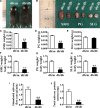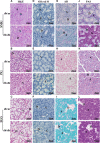Disruption of tight junctions contributes to hyposalivation of salivary glands in a mouse model of type 2 diabetes
- PMID: 32374057
- PMCID: PMC7476205
- DOI: 10.1111/joa.13203
Disruption of tight junctions contributes to hyposalivation of salivary glands in a mouse model of type 2 diabetes
Abstract
Tight junction (TJ) plays an important role in regulating paracellular fluid transport in salivary glands; however, little is known about the involvement of TJs in diabetes salivary glands. This study aimed to investigate the alterations of TJs and their possible contribution in diabetes-induced hyposalivation. Here, we observed that the morphologies of submandibular glands (SMGs) were impaired, characterized by enlarged acini accumulation with giant secretory granules, which were significantly reduced in atrophic ducts in SMGs of db/db mice, a spontaneous model of type-2 diabetes. However, the secretory granules were increased and scattered in the acini of diabetes parotid glands (PGs). Other ultrastructural damages including swollen mitochondria, expansive endoplasmic reticulum, and autophagosomes were observed in the diabetes group. The levels of TJ proteins including claudin-1 (Cldn1) and claudin-3 (Cldn3) were increased, whereas those of claudin-4 (Cldn4), occludin (Ocln), and zonula occludens-1 (ZO-1) were decreased in SMGs of db/db mice. Higher Cldn1 and Cldn3 and lower claudin-10 (Cldn10) and Ocln levels were observed in PGs of diabetes mice. Taken together, the structures of SMGs and PGs were impaired in diabetes mice, and the disruption of TJ integrity in both SMGs and PGs may contribute to diabetes-induced hyposalivation.
Keywords: diabetes; saliva; salivary gland; submandibular gland; tight junction.
© 2020 Anatomical Society.
Figures





Similar articles
-
Disruption of tight junction structure contributes to secretory dysfunction in IgG4-related sialadenitis.J Mol Histol. 2020 Feb;51(1):33-46. doi: 10.1007/s10735-019-09854-8. Epub 2019 Dec 21. J Mol Histol. 2020. PMID: 31865502
-
Interleukin-17 Impairs Salivary Tight Junction Integrity in Sjögren's Syndrome.J Dent Res. 2016 Jul;95(7):784-92. doi: 10.1177/0022034516634647. Epub 2016 Mar 1. J Dent Res. 2016. PMID: 26933138
-
Expression patterns of tight junction proteins in porcine major salivary glands: a comparison study with human and murine glands.J Anat. 2018 Aug;233(2):167-176. doi: 10.1111/joa.12833. Epub 2018 May 31. J Anat. 2018. PMID: 29851087 Free PMC article.
-
The role and mechanism of tight junctions in the regulation of salivary gland secretion.Oral Dis. 2024 Jan;30(1):3-22. doi: 10.1111/odi.14549. Epub 2023 Mar 21. Oral Dis. 2024. PMID: 36825434 Review.
-
Current trends in salivary gland tight junctions.Tissue Barriers. 2016 Mar 10;4(3):e1162348. doi: 10.1080/21688370.2016.1162348. eCollection 2016 Jul-Sep. Tissue Barriers. 2016. PMID: 27583188 Free PMC article. Review.
Cited by
-
BuZhong YiQi Formula Alleviates Diabetes-Caused Hyposalivation by Activating Salivary Secretion Pathway in the Parotid and Submandibular Glands of Rats.Pharmaceuticals (Basel). 2025 Mar 6;18(3):377. doi: 10.3390/ph18030377. Pharmaceuticals (Basel). 2025. PMID: 40143153 Free PMC article.
-
Gemigliptin Improves Salivary Gland Dysfunction in D-Galactose-Injected Aging Rats.Pharmaceutics. 2023 Dec 26;16(1):35. doi: 10.3390/pharmaceutics16010035. Pharmaceutics. 2023. PMID: 38258046 Free PMC article.
-
Micronutrient Improvement of Epithelial Barrier Function in Various Disease States: A Case for Adjuvant Therapy.Int J Mol Sci. 2022 Mar 10;23(6):2995. doi: 10.3390/ijms23062995. Int J Mol Sci. 2022. PMID: 35328419 Free PMC article. Review.
-
Cellular Senescence Contributes to the Dysfunction of Tight Junctions in Submandibular Glands of Aging Mice.Aging Cell. 2025 May;24(5):e14470. doi: 10.1111/acel.14470. Epub 2025 Jan 9. Aging Cell. 2025. PMID: 39789829 Free PMC article.
-
Exploring the impact of advanced glycation end products on diabetic salivary gland dysfunctions.Glycoconj J. 2025 Apr;42(2):97-106. doi: 10.1007/s10719-025-10182-1. Epub 2025 Mar 25. Glycoconj J. 2025. PMID: 40131578 Review.
References
-
- Amoozadeh, Y. , Dan, Q. , Anwer, S. , Huang, H.H. , Barbieri, V. , Waheed, F. et al. (2017) Tumor necrosis factor‐alpha increases claudin‐1, 4, and 7 expression in tubular cells: role in permeability changes. Journal of Cellular Physiology, 232, 2210–2220. - PubMed
-
- Anderson, L.C. and Garrett, J.R. (1986) Lipid accumulation in the major salivary glands of streptozotocin‐diabetic rats. Archives of Oral Biology, 31, 469–475. - PubMed
-
- Anderson, L.C. , Suleiman, A.H. and Garrett, J.R. (1994) Morphological effects of diabetes on the granular ducts and acini of the rat submandibular gland. Microscopy Research and Technique, 27, 61–70. - PubMed
-
- Beltrame de Oliveira, R. , Matheus, V.A. , Canuto, L.P. , De Sant'ana, A. and Collares‐Buzato, C.B. (2019) Time‐dependent alteration to the tight junction structure of distal intestinal epithelia in type 2 prediabetic mice. Life Sciences, 238, 116971. - PubMed
Publication types
MeSH terms
Substances
LinkOut - more resources
Full Text Sources
Medical
Miscellaneous

